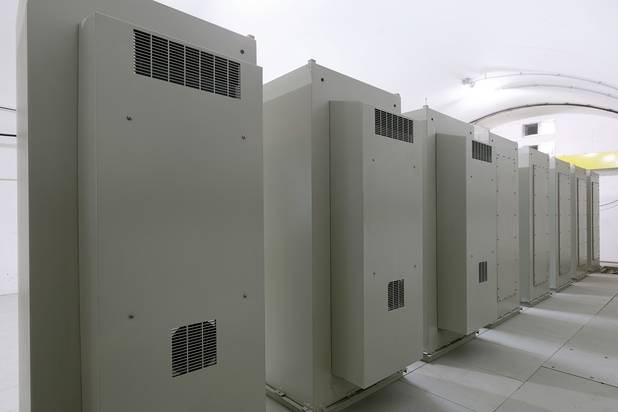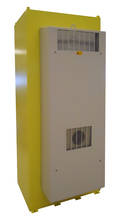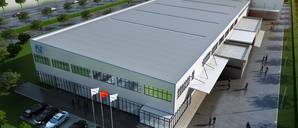Case Study
Safety and system uptime in the St. Gotthard Base Tunnel.
Two competent partners – one solution: electrical enclosure manufacturer and thermal management specialist develop a concept that withstands the alternating pressure load in tunnels.
The Gotthard Base Tunnel impresses with many outstanding figures: It is the longest railway tunnel in the world at 57 km and its tunnel run, with all the transverse and connection tunnels, stretches over 154 km. From 2016, passenger trains should have a top speed of 250 km/h, reducing the travelling time e.g. between Milan and Zurich to under 3 hours and should almost double the haulage capacity on the Swiss North-South Axis to 40 m tons of goods.
Looking at these figures, it becomes clear that the safe and smooth operation in the tunnel must be guaranteed at all times. In order to achieve this level of safety, the technology used in the tunnel must always be up to date; this applies not only to the whole system, but also to the individual components. The most important components here are Pfannenberg’s electrical enclosure climate control units, which are situated, in the 176 cross passages amongst other places.
These climate control units or cooling units ensure that the thermal pressure of the electronic components integrated inside the electrical enclosures does not become too high and that they work safely and reliably throughout their whole service lives.

Pfannenberg and Swibox – a time-tested team.
Two long-term partners have joined forces once more for the Gotthard Base Tunnel project: Pfannenberg, a medium-sized company with its headquarters in Hamburg and specialist for the thermal management and process cooling of electrical enclosures, and the company Swibox, also an expert in the area of customised electrical enclosure manufacture with its headquarters in Balterswil in Switzerland.
At the beginning of the cooperation, standard products from Pfannenberg’s comprehensive portfolio of products were installed in the Swibox switch cabinets. The first time the two companies developed a climate control concept for a specific customer was 2003, during the “Lötschberg Tunnel” project. This concept was designed especially for the challenging demands of railway tunnel applications.
Electrical enclosures withstand ever alternating pressure.
The largest technical challenges were the high requirements to the system of protection of the electrical enclosure, IP 65, and also the high alternating pressure load which is caused by the trains passing through. When entering the tunnel, the train pushes the air ahead of it, causing overpressure until the train passes by the cross passage where the electrical enclosures are standing. As soon as the train has passed, the overpressure transforms suddenly to a corresponding under-pressure. All the electrical enclosures and the installed cooling units are exposed to the load of this alternating pressure of up to ±5 kPa. (figure 2 cross passage Lötschberg Tunnel with electrical enclosures and climate control units). It had to be ensured that all devices can withstand this alternating pressure mechanically, simultaneously implementing the high system of protection.

It was possible to meet these requirements, thanks to the mechanical unit construction (figure 3: Swibox electrical enclosure with Pfannenberg DTGT cooling units without top cover) developed especially in cooperation with the company Swibox. This construction ensures a leak-proof separation of the surrounding (outer wall of the unit) and the inside of the electrical enclosure (unit inside), also under pressure load. A special feature here is the developed pressure body inside which the components of the inner cooling circuit are housed. Therefore, it was not enough to use reinforced sheet metal: the selection of a suitable material and the increased material thickness in combination with specially installed stiffening plates led to the desired compressive strength.

Climate control concept of electrical enclosures does not only mean cooling.
Another challenge in tunnels is the ambient air. Large temperature differences ranging from –20 °C to +40 °C, maximum humidity of 100 %, and ferrous abrasion of brakes, rails and contact lines in the ambient air increase the risk of corrosion and show how different a tunnel application is compared to standard applications.
Therefore, a special climate control concept had to be established for specifically this application. It becomes clear that it is not just about the cooling of the components when you look closely at the task of thermal management and process cooling of electrical enclosures again. It comprises an extensive protection for the electronic components against damaging ambient influences such as dust, moisture and temperature.
Naturally, protection plays a special role, but also other factors can be influenced by thermal management and process cooling such as the length of service life of the electronic components for example. Many developers and design engineers are aware of the fact that climate control of electrical enclosures is necessary, but often not where the actual requirement comes from. Here it is helpful when one looks at the technical data of frequently installed components closely, especially cost intensive components like controllers. The technical data includes information on minimum/maximum operating temperature, humidity, and condensate but also on other critical parameters like the dust pollution.
The controllers in modern electrical enclosures are based on semi-conductor components. The monitoring elements and control elements used are becoming more and more powerful. The extremely high packing densities result in a higher power loss. The larger the temperature stress of these components, the shorter their service life. Thus, it can lead to overheating, the so-called hotspots and in the worst case premature failures.
Humidity is another parameter which has to be assessed within the framework of a concept for the thermal management and process cooling of electrical enclosures. In the ambient air there is always a proportion of dissolved water. Depending on the temperature, the air can absorb a larger or smaller amount of water. If the temperature drops e.g. due to day/night change, there is a risk of condensation building on and between the electronic elements. Corrosion and electronic failures can be a consequence here, too.
Since 2005 we have started to implement the climate control concept we developed together. In addition to the cooling units, which are predominantly used inside the mountains (ambient temperatures up to +40 °C), Pfannenberg heaters also had to be installed in the portal sector (ambient temperatures to –20 °C).
These heaters ensure that the temperature inside electrical enclosures does not fall below the so-called dew-point. The dew-point is the temperature that moist air has to drop to – by unchanged pressure – so that the amount of water dissolved in the air is precipitated as condensate. At the dew-point, the relative humidity is 100 %; that means that the air is saturated with water vapour.
The successful collaboration between both companies is to be continued in form of the new project Gotthard Base Tunnel. In 2006, work was started on a solution for the increased requirements of thermal management and process cooling of electrical enclosures on the basis of the tried and tested concept. For example, the demands on the alternating pressure load with ±10 kPa doubled, which made it necessary to completely rework the mechanics of the cooling units. In a Swibox test laboratory developed especially for such projects, the new design and the electrical enclosure proved their functionality – successfully running through 200,000 alternating pressure loads ±10 kPa.

Controllers ensure system uptime.
The integration of the electrical enclosure climate control units (figure 4: Pfannenberg cooling unit DTGT mounted on the back of the electrical enclosure) into the central tunnel system was a further requirement which had to be implemented. As a result of the integration, there will be the possibility to access all operating data of the cooling unit in the future.
Thus, the current temperature of the electrical enclosure can be read for example, or the hours of operation of the most important main components can be monitored. This is especially important to prevent unplanned failures and downtime and, by planning maintenance works in advance, to guarantee a high level of system uptime.
Pfannenberg’s new generation of controllers, designed especially for this project, have an ethernet transmission protocol, and provide a variety of parameters which can now be monitored in the central tunnel control. These heaters ensure that the temperature inside electrical enclosures does not fall below the so-called dew-point. The dew-point is the temperature that moist air has to drop to – by unchanged pressure – so that the amount of water dissolved in the air is precipitated as condensate. At the dew-point, the relative humidity is 100 %; that means that the air is saturated with water vapour.
The controllers are not only used directly inside the cooling units. The climate controller was also integrated into 500 other electrical enclosures without a cooling unit. This makes a temperature monitoring system possible, which, like the climate control units, can communicate with the tunnel control system and, if necessary, can be replaced with such, without having to reinstall the data transfer.
Another first in this development is attention paid to energy efficiency. An intelligent control concept was implemented for this, optimising the energy efficiency, which is already very good in the active cooling mode, additionally in the passive mode (only the electrical enclosure air is circulated). Due to the integration of a temperature sensor at the allegedly most critical point inside the electrical enclosure, the internal fan responsible for the circulation of the air in the electrical enclosure is only switched on when a defined limit temperature is exceeded. The cooling unit does not start to cool actively again until a limit temperature is exceeded despite the circulation of the air. This control concept helps to reduce the energy consumption further, since all active components are switched off in the event of the energy saving mode described above.
Another important point is that the uptime of the units is guaranteed to last for 10 years after the initial operation of the tunnel in 2016. This results in the increased demands to maintenance friendliness. Thus, the MTTR (Mean Time to Repair) has to be as short as possible, this means the time necessary to replace the components quickly and easily in the framework of defined maintenance work.
In 2010 the first cooling units were delivered to the company Swibox. In the meantime, all units have been delivered and will be installed one by one, together with the electrical enclosures, in the 176 cross passages of the Gotthard Base Tunnel. They have already been able to prove their reliability every day, as the various test phases started a while ago and will continue until the start of the scheduled railway operation on 2016.
Summary.
Operating a tunnel poses a huge challenge for engineers and operators time and time again. All products and solutions have to meet the highest requirements and have to work perfectly even under harsh ambient conditions. In particular, this applies to electrical enclosures and their thermal management, which are subject to extreme alternating pressure loads, temperature differences and are also exposed to dust and moisture. In close collaboration, Swibox and Pfannenberg have developed a special climate control concept for tunnel applications. Robust Swibox electrical enclosures with a pressure body which was developed especially to protect the cooling circuit and the side mounted cooling units with integrated controller and heater from Pfannenberg guarantee a high system uptime.
Facts at a glance.
Task
- Development of an electrical enclosure climate control concept for 176 cross passages in the St. Gotthard base tunnel.
Project period for equipment installation
- 2013 / 2014.
Challenges
- Alternating pressure loads of up ±10 kPa.
- Temperature differences ranging from –20 °C up to +40 °C.
- Humidity up to 100 %.
Technique applied
- DTGT 9041, DTGT 9541; approx. 980 units.
Success factors
- Especially developed pressure body with integrated circuit.
- Pfannenberg's new generation of controllers with ethernet transmission protocol for central tunnel control.
- Intelligent control concept fro energy efficiency.
- Uptime of the units is guaranteed to last for 10 years and defined maintenance work for short MTTR.
| 描述 | 語言 | 类型 | 大小 | 下载 |
|---|---|---|---|---|
Case Study Gotthard base tunnel |
|
1.5 MB | 下载 |
